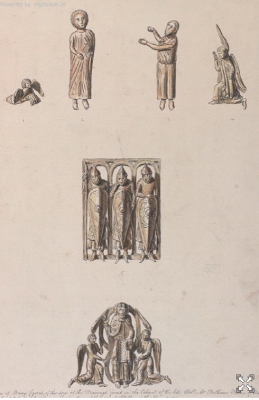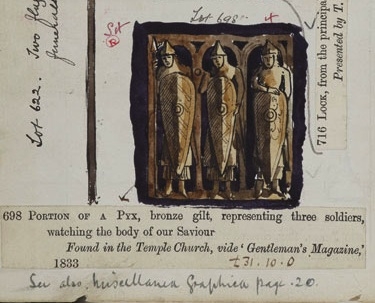To search the RPR site click here
Three bronze sleeping soldiers Add.9455vol2_p397 /4
Dan Hicks, the Lecturer-Curator in Archaeology at the Pitt Rivers Museum, whilst researching the forthcoming publication XXXX identified some information relating to a possible item from Pitt-Rivers' second collection and sent the details to this researcher to be identified further.
The information he had found was on the Archaeology Data Service here. It described a drawing in the Society of Antiquaries of London's collections (see the first image on this page). The description read:
The page has drawings of six bronze plaques: (left to right) an angel; two separate figures, one with a book; another angel; three sleeping soldiers in Norman armour; and Christ in a mandorla supported by two angels. The note in the Gentleman's Magazine (see Bibliography) refers to the bronze of the three sleeping soldiers being found in the Temple Church during 'recent' repairs. Its suggested use was as an applique to a small shrine or pyx. The English Romanesque Art catalogue (see Bibliography) dismisses the Temple Church provenance, and argues that the object represents a depiction of the Holy Sepulchre. This drawing is significant because only the three knights survive (in the Burrell Collection, Glasgow); the other plaques have disappeared. A note in pencil on the opposite page of the album (fol. 1v) refers to the sleeping soldiers in bronze as being in the collection of General Pitt Rivers in 1890. He obtained it in a Sotheby's sale 10 July 1888.
Material: paper
Technique: Drawing. Yellow and grey washes using the medium of Pen and Ink
Measurements: Height 391 mm Width 290 mm
Inscription: Handwritten on the bottom was ""A Collection of Bronze figures, of the Size of the Drawings, found in the Cabinet of the late Revd. Mr Betham Fellow of Eton College, and apprehended to be taken from a Tomb-Stone, of the age of William the Conqueror. see Ants. Journal 1941 p. 161. Gents 1833 Vol II p. 305. Similar to the above Engraved in the Gents Magazine."
Bibliography: Antiquaries Journal 21 (1941): 161. Illustrations, pl. XXXII, opp. p. 160; pl. XXXIII, between pp. 160 and 161. A note by T D Kendrick. He refers to the rediscovery of the drawing when a selection of books for wartime evacuation was being made at the Society of Antiquaries of London. English Romanesque Art, 1066-1200: Hayward Gallery, London, 5 April - 8 July 1984 (London: Weidenfeld and Nicolson, 1984), p. 242-3, no. 234. Illustration of this drawing (Photograph), p. 243, no. 234. Gentleman's Magazine 103 (1833): 305-6. Illustration, pl. II, opp. p. 305. T D Kendrick, 'The Temple Pyx', Antiquaries Journal 16 (1936): 51-4.
People: Rev Edward Betham, Burrell Collection, TD Kendrick, Augustus Lane Fox Pitt-Rivers.Date: (of object rather tahn drawing) mid 12th century Medieval Romanesque
This object depicted in the drawing was supposed to be a pyx, a small round container used in the Catholic, Old Catholic and Anglican Churches to carry the consecrated Host. It was eventually traced to be Add.9455vol2_p397 /4. The catalogue of the second collection described it as:
Description of object: The Earl of Londesborough ... Lot 698 [Drawing]
Added: 698 Portion of a Pyx, bronze gilt, representing three soldiers, watching the body of our Saviour Found in the Temple Church, vide ‘Gentleman’s Magazine 1833
Added” See also Miscellanea Graphica page 20
Added: £31.10.0
Added: From the introduction to Miscellanea Graphica by T. Wright page 20 The following cut represents a portion of another Pyx (in the collection of Lord Londesborough ), which has been ascribed to the earlier part of the twelfth century. It is of brass, or bronze, thickly gilt, but without enamel. The figures represent three soldiers keeping watch over the tomb in which the body of our Saviour - suppused [sic] to be contained in the consecrated wafer - was laid. This curious object was found in the course of alterations made in the Temple Church some years ago, and was formerly in the collection of the late Mr Crofton Croker.
Price: Lot 698 £31.10.0
It is clear that the information that the Society of Antiquary's had about it was not entirely correct. The object was probably sold to Pitt-Rivers on the 10 July 1888 but it was acquired at the Christie's, London auction sale of items from the sale of Albert Denison Conyngham, first Baron Londesborough also known as Lord Londesborough's collections, held between 4 and the 11 July 1888.
Albert Denison Conyngham, first Baron Londesborough, was a politician and diplomat who served in Berlin, Vienna and Italy. He was also Liberal MP for Canterbury. He was very interested in archaeology and an art connoisseur; a fellow of the Royal Society and of the Society of Antiquaries. His famous collection of antiquities was dispersed principally in four London sales in 1879, 1884, and 1888, some 20 years after his death in 1860. These sales were very popular with other collectors, for example, John Evans also acquired some objects from this collection [Macgregor (ed) 2008: 137]
Conyngham was said to have acquired the bronze from Thomas Crofton Croker (1798-1854), an Irish antiquary born in Cork who worked at the Admiralty in London. He was particularly interested in Irish folklore. Thomas Bateman also acquired items from his collection, see here for more information.
The Temple Church is the church of the Inner and Middle Temple, two of England's four ancient societies of lawyers, the Inns of Court. Its website states:
The Church was built by the Knights Templar, the order of crusading monks founded to protect pilgrims on their way to and from Jerusalem in the 12th century. The Church is in two parts: the Round and the Chancel. The Round Church was consecrated in 1185 by the patriarch of Jerusalem. It was designed to recall the holiest place in the Crusaders' world: the circular Church of the Holy Sepulchre in Jerusalem. It is a numinous space - and has a wonderful acoustic for singing.
The Temple Church was consecrated in honour of the Blessed Virgin Mary on 10 February 1185 by Heraclius, Patriarch of Jerusalem.
The whole Temple community had moved from an earlier site in High Holborn, considered by the 1160s to be too confined. The church was the chapel serving the London headquarters of the Knights Templar, and from them it took its name. The Templars - as the knights were popularly known - were soldier monks.
After the success of the First Crusade, the order was founded in Jerusalem in a building on the site of King Solomon's temple. Their mission was to protect pilgrims travelling to and from the Holy Land, but in order to do this they needed men and money. For more details of the Templars and this early history of the Church, see The Round Church, 1185.
The London Temple was the Templars' headquarters in Great Britain. The Templars' churches were always built to a circular design to remind them of the Church of the Holy Sepulchre at Jerusalem, a round, domed building raised over the site of the sepulchre where Jesus was buried. At first, the Templars were liked and respected. St Bernard of Clairvaux became their patron and they gained many privileges from popes and much support from kings.
In England, King Henry II was probably present at the consecration of the church; King Henry III favoured them so much that he wished to be buried in their church. As a consequence of this wish, the choir of the church was pulled down and a far larger one built in its place, the choir which we now see. This was consecrated on Ascension Day 1240 in the presence of the king. However, after Henry died it was discovered that he had altered his will, and he was buried in Westminster Abbey.
Read more about the history of this Church at this time here. It would seem that the sleeping soldiers bronze dates from early in the Church's history.
It would seem that the bronze is now in the care of the Burrell Collection, Glasgow. We are currently awaiting more information from the Burrell Collection about this object and what is known about it now.
AP May 2012





